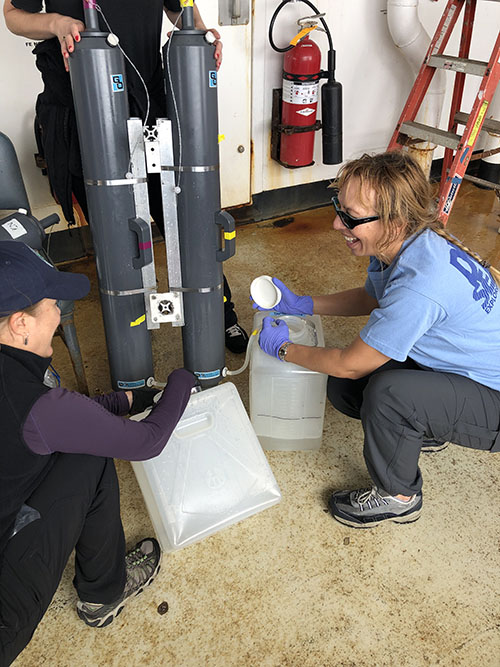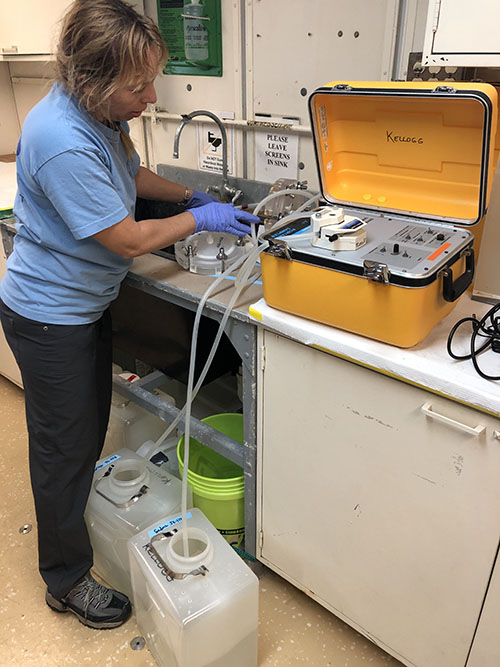
By Cheryl Morrison, Research Geneticist, U.S. Geological Survey
Christina Kellogg, Research Microbiologist, U.S. Geological Survey
What can a bottle of water tell you? Well, if the water was collected from the deep sea, maybe a lot! We’re hoping that bottles of water collected from several sites during this cruise will give us insight into the dominant microbial processes, what food options the animals in the habitat have, and if it is possible to detect the presence of larger organisms like corals and fish from their environmental DNA (eDNA) in the water.
Organisms leave behind traces of DNA in their surrounding environment in the form of tiny particles such as scales, mucus, and feces. This eDNA can be collected by sampling environments such as seawater, freshwater, or sediment. On this cruise, we are sampling deep-sea water that likely contains eDNA.
To make these collections, we are putting large volume (12 liter) Niskin bottles on remotely operated vehicle (ROV) Jason that will collect water just above the surface of the various seafloor types. In order to keep track of the water samples and replicates, we've tagged the bottles with different colored tape and named them: Darya (Iranian for ‘sea’) and Sedna (the Inuit goddess of the sea).

The two Niskin bottles used to collect deep-sea water samples are mounted to the bottom of ROV Jason and can be triggered by the ROV’s manipulator arms. Image courtesy of DEEP SEARCH 2019 - BOEM, USGS, NOAA. Download larger version (jpg, 704 KB).
The eDNA in water samples may also reveal the diversity of tiny organisms (plankton) that are available as food for benthic organisms such as corals. Through a process called metabarcoding, we will sequence DNA obtained from the water samples and compare the sequences to databases of known organisms, allowing us to identify what organisms were represented in our samples.

Cheryl Morrison prepares sections of sterilized tubing that she’ll use to transfer water from the Niskin bottles into sterile containers. Image courtesy of DEEP SEARCH 2019 - BOEM, USGS, NOAA. Download larger version (jpg, 4.2 MB).

Cheryl Morrison and Christina Kellogg collect water from the two Niskin bottles after they were removed from the ROV post-dive. Image courtesy of DEEP SEARCH 2019 - BOEM, USGS, NOAA. Download larger version (jpg, 5.6 MB).
Researchers have begun using techniques like these, called “metagenomics,” to provide information about the possible ways that different organisms function in an ecosystem, particularly in shallow coral reef systems. On this cruise, we will sample water from just above the seafloor, which will tell us about the microbial community of deep-sea coral habitats, seep habitats, and sediment habitats. We can connect this metagenomic work to the eDNA studies to get a more complete picture of the food webs in these ecosystems.

Christina Kellogg uses a peristaltic pump to circulate the water through a filtration device. The filter will collect all of the microbes in the water sample, which Chris will then further analyze when she’s back on land. Image courtesy of DEEP SEARCH 2019 - BOEM, USGS, NOAA. Download larger version (jpg, 4.2 MB).
We may also detect the presence of organisms that we weren’t able to observe with the ROV, such as fishes and invertebrates like octopus and squid, allowing documentation of animals that may have gone unnoticed otherwise. Stay tuned as we apply these new technologies to explore the deep!